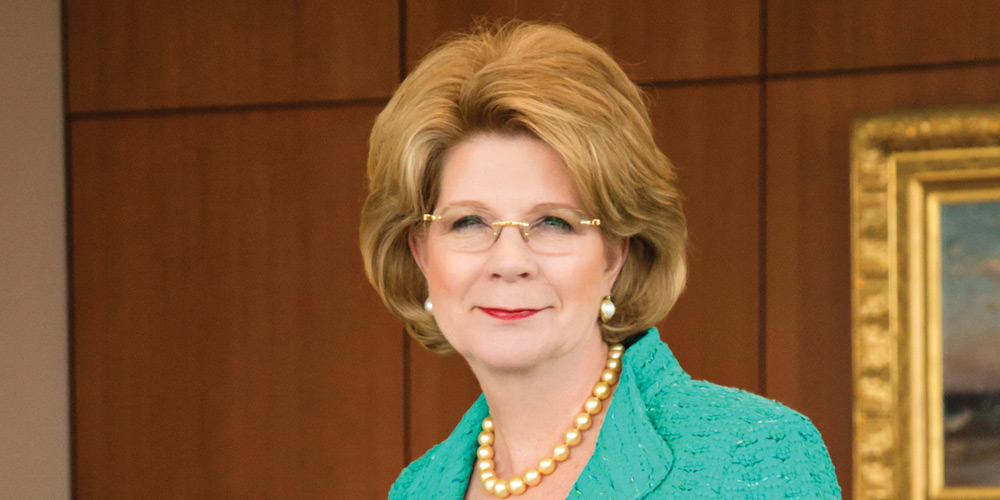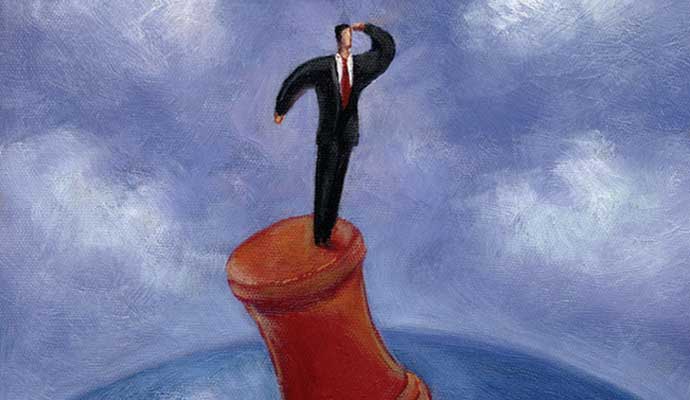Leading with a mission mind-set
How Beth Mooney, CEO of KeyCorp and chair of the Cleveland Clinic, earns trust in banking and healthcare.
This interview is part of the Inside the Mind of the CxO series, which explores a wide range of critical decisions faced by chief executives around the world.
When Beth Mooney heard about a management training program at the Republic Bank (now Republic Bancorp) in Dallas in 1979, she showed up there — and refused to leave the training manager’s office until he offered her a position. Two years earlier, she’d graduated from the University of Texas, Austin, summa cum laude. But on job interviews, the first question people asked was, “How fast can you type?” She got the job at Republic Bank on one condition: that she follow up her history degree with an MBA, which she began pursuing.
More than three decades later, in 2011, Mooney became the first female CEO at a top 20 U.S. bank when she took over at Cleveland-based KeyCorp. The Fortune 500 company, which has US$137 billion in assets, concentrates on middle-market clients and consumers, and has more than 18,000 employees and 1,100-plus branches in 15 states.
Mooney was vice chair and head of Key Community Bank, part of the KeyCorp banking network, when the subprime mortgage crisis decimated much of the retail banking sector. In a move widely regarded as prescient, the bank had stopped issuing mortgages to first-time home buyers two years before the recession hit, escaping much of the turbulence that roiled the rest of the industry.
Under Mooney’s leadership, KeyCorp, which also includes a corporate bank division, is widely considered a model in the digital transformation of its online and mobile banking experience. Mooney also is a strong proponent of diversity and inclusion. KeyCorp has been named a top employer for diversity and LGBTQ rights, and won praise as a disability employer. KeyCorp’s board of directors reflects that commitment to diversity, with half its members belonging to a minority group, and 30 percent of the company's leadership team is female, compared with an industry average of just 8 percent.
In May 2019, Mooney became the first woman to assume the role of chair of the Cleveland Clinic, one of the top-ranked hospitals and medical research centers in the United States. Recently, strategy+business sat down with her at the KeyBank headquarters in her glass-walled 56th-floor office with sweeping views of Lake Erie to discuss her plans for staying ahead of the digital transformation curve, and examine the parallels between finance and healthcare — where earning and keeping trust are vital to success.
S+B: How would you describe your leadership approach? Has your experience in finance prepared you for the healthcare industry?
MOONEY: While I’m certainly nowhere close to an expert in any area of healthcare per se, I do bring business acumen as well as a mission mind-set to the role. The Cleveland Clinic is a nonprofit education and academic research institution as well as a leading patient care provider [both] for population health and for highly complex cases. It plays a critical role in the healthcare fabric of our community, but it’s also global. The business leadership skills I bring help create a quality workplace so that caregivers can be at their best and safest. This is for people who clean the rooms to someone on the front lines of an operating theater. At the bank, I call it “from the bottom of the building to the top, and from the front of the office to the back room.”
The clinic runs like a business, too, so having business leadership on the board side creates a nice alignment. It is physician-led in terms of management, so this brings a balance between the structures of the board: leadership and management.
S+B: Obviously, trust is an important currency in both finance and healthcare.
MOONEY: It is the most important currency in both.
S+B: How do you preserve and strengthen the confidence of both the patient and the bank customer at a time when trust in institutions is falling?
MOONEY: You think in terms of the culture you build and the standards you set. It’s all about meeting the client or patient’s needs, then striving for excellence, while always being transparent about outcomes. So, to me, the trust piece is creating a culture and a product that meets people’s needs, whether that’s helping them with the health of their financial life or the health of their physical life. You have to do it in a way that shows you care. That’s where you demonstrate your mission mind-set.
Transparency resonates with people. They’ve got to know that you will tell them the truth and that you will be forthcoming. They’ve got to be able to rely on you doing what you say you are going to do.
Trust matters most in these industries because people are at their most vulnerable when it comes to their financial health and physical health. These are matters many feel the least equipped to understand. And if you’re seriously ill, you’re at the mercy of people who know how to make you well. There’s probably no [greater] point of [first] vulnerability and then ultimate gratitude than when you are being treated for an illness.
S+B: And in banking?
MOONEY: We’re saving lives at the clinic, but helping people with their financial lives is very important, too. All the research shows that most people aren’t fully informed or confident enough to make financial decisions that will help build their future. So yes, there are more corollaries between our industries than not.
S+B: In PwC's 22nd Annual CEO Survey, many leaders expressed concerned about the digital skills gap in their workforce. How are the technological disruptions that are facing business today affecting what you do?
MOONEY: The new global digital skill sets and economy are intersecting in every business. At KeyBank, we want customers to interact with Key across the continuum so that it feels familiar, whether it’s through a digital platform or a branch. We spend a lot of time integrating the physical and digital experiences so customers can choose — and we’ve learned that people want both. What we used to think was a skill set only a 20- or 30-year-old would have is [now common]. Plenty of 60- and 70-year-olds are getting digitally savvy. The decades are collapsing, so you’ve got to lean into the digital world.
AI and digital technology are also going to transform healthcare, from how you’re being treated or diagnosed to how you book an appointment and go to the doctor. It’s also going to help us manage the pace of new knowledge. What was known about the cause and treatments of diseases used to change every 10 to 20 years. Now it’s something like every seven months.
S+B: Do internal upskilling programs help you meet these challenges? Or do you rely more on local universities?
MOONEY: Early on in my tenure here, I hired someone, who is now our head of HR, to help us build what I call the foundation of a very robust training and leadership development culture. This is going to serve us well for the future skilling of the workforce as the nature of work is impacted by digitization and emerging technology, such as AI and machine learning. In the banking industry we have deployed these systems that actually learn and understand patterns and become predictive of instances of fraud, for example. But we have gone as far as algorithms, machine learning, and artificial intelligence can ultimately take us without the leadership skills and ability to understand certain kinds of behavior and data. Ensuring that people have these leadership and contemporary skills in order to thrive in your workforce is a huge responsibility for employers. We’ve done most of that work on our own, but there is probably a technical component that will require more active partnerships in the future.
S+B: What’s been the greatest challenge of your career so far?
MOONEY: I’ve been fortunate to have had many career challenges, because all of them have contributed to my skills and perspective. You need to come out of them humble and realize that making good decisions and charting a path is never easy. The Great Recession was a very challenging time to be in financial services. I had a front-row seat. [I saw] just how fragile the economy and our financial system was, and it was sobering.
Plenty of 60- and 70-year-olds are getting digitally savvy. The decades are collapsing, so you’ve got to lean into the digital world.”
Coming through that time wasn’t just about making sure you made decisions that allowed your company to weather the downturn, but also about harvesting those learnings to build a better business model so as not to repeat those mistakes. As a result, there has been a focus on creating something that’s more purpose-driven and values-based that meets your clients’ needs, and is also perhaps more conservative and mindful of the risks while still providing good shareholder returns.
Before the recession, business models were canted toward the side of generating returns, without looking at it more holistically. I came out of that downturn realizing that you must see the business as multidimensional, making sure there is value being both given and received. And that it’s not just growth for growth’s sake, but growth within the risk profile. The Great Recession created a more nuanced and sophisticated way of running a business that has been healthy.
S+B: Do you think the finance industry has learned this across the board?
MOONEY: I do think our industry in general reflects that experience. And obviously there was the regulatory response. How we interact with our regulators, how we manage our capital, what we get evaluated on, is now very different. My goal, when I got to be CEO, because I was part of the new leadership immediately following the downturn, was to rebuild the trust of the customers and community, as well as [that of] the regulators and our shareholders. There’s a whole continuum of trust, but it doesn’t start with the shareholders. If shareholders are the only focus, you lose sight of the value needs and trust needs of the clients, the employees, and the communities. It was when people [forgot that] that they lost their value proposition.
S+B: Yet in a publicly traded bank, doesn’t the pressure come from those shareholders looking for quarterly results?
MOONEY: You must balance how you make decisions to create the right kind of performance and investment that can be successful in the short run, but it is more important to have a long-term strategy and vision of where you’re trying to take the company. You need to see where the industry is going, while being good at resource allocation, investment decisions, and where you build the skill sets of your people. One of the most important things any CEO does is have that vision and strategy, but it’s something you can’t technically manage day in and day out. A vision isn’t enough. You’ve got to have a plan, and that plan needs to be taking you somewhere. Every single day you get up and conduct yourself as someone who feels the need to earn the right to continue as leader. And that’s something you can never take for granted. Every day, as a leadership team, we ask ourselves if we are the right people to run this company. There’s got to be a bit of fire in your belly to do the right things the right way.
S+B: Today we live in a world of growing economic inequality. What responsibility do business leaders have to address this?
MOONEY: As leaders in our industries and our communities, I look at what I call the opportunity and the obligation we all have to make sure that what we’re doing is creating value, based on values. It’s about your employees. It’s about your clients. It’s about supporting your communities, [knowing] where creating value would be good for your shareholders. It must be the mind-set of not just business leaders, but policymakers and practitioners in both the public and private sectors. We must take on the obligation part, not just the opportunity part, and really balance how we approach things to ask ourselves, “Are we creating equitable opportunities? Are we creating something of value? Are we lifting up as we go, not just innovating at the margin for some better outcome?”
We’ve got to think in terms of the economic consequences for our constituents. It is the mantle of leadership at this juncture in our history to do this better. Because if you go back 20, 30 years ago, I’m not sure some of the disparities that we’re dealing with now were as evident. People were doing things more in isolation.
It’s the same thing with climate change. My father was a chemist at Dow Chemical who helped create all these plastic products that were just transformational: Saran wrap and the foam trays that you put meat on that you wrap in plastic that you can sell. Back then it was the product of cutting-edge research — and within a generation, it’s part of what’s causing the garbage islands [in the oceans].
We need to think more holistically about the knock-on effects, and make sure we address them more proactively, at the front end, not as they emerge as the issue you didn’t see on the horizon.
S+B: You’re a leader in both healthcare and finance, where the populations of employees are predominantly female and male, respectively. Is there more work to be done in terms of building more diversity and inclusiveness into the cultures of both industries?
MOONEY: Having more diverse and inclusive cultures has been a very intentional part of my leadership journey. The tapestry [of the business] is the diversity of our employees, but inclusion is how it gets woven in, because it is about creating a culture where people can truly be their best and most authentic selves. This is rooted in my early days in business, where [success] was more [determined by] how you fit in, and how you looked, thought, and acted like those around you, so they might not wake up and notice you were female. Of course, you had to bring your best self to work, but not necessarily your full, authentic self.
There is a cascading effect when you put a stake in the ground with respect to diversity and inclusion. The Cleveland Clinic is a very diverse place among all levels of caregivers. But as with most organizations, there’s always more to be done at the leadership level. It starts at the top. There was a moment when I got named chair that took me back to when I got named CEO of Key. My favorite email came from one of our branch managers. She said, “You don’t know me, but you have no idea how much it means to me that our next CEO is going to be a woman. Because I’m going to go to work tomorrow and stand a little taller, and walk a little prouder.”
The day it was announced that I was going to succeed Bob [Rich] as chair, dozens of women who work at the clinic in various capacities came to me and said, “This is a great day.” We should never take any of this for granted. The playing field is perhaps more level, but that doesn’t mean it isn’t a big deal to have a “diverse” leader put in this position, whether for something as iconic and global as the Cleveland Clinic or a Fortune 500 bank. It also reminds me that because you’re blazing a trail for others, there’s this obligation to do it well.
Author profile:
- Samantha Marshall is a journalist and best-selling book collaborator based in the United States.




